Contents
Although thuja, regardless of variety, is famous for its resistance to harmful environmental factors and infections, it can still occasionally be subject to certain diseases. And therefore, all connoisseurs of this plant need to have an idea not only about its agricultural technology, but also to study thuja diseases and their treatment in as much detail as possible.
Signs of the appearance of pests and diseases in thuja
Everywhere, thuja is considered an unpretentious plant, the care of which does not require excessive effort, and this is true. However, a careless attitude to this shrub quickly makes itself felt. Violations made during cultivation are reflected both in the decorative qualities of the thuja and in the state of its growth. This is also true in case of infection with a disease or attack by pests. Often, the following signs help to understand that something is wrong with the plant.
- shrub growth slowdown;
- changing the color of the needles to black, brown or yellow;
- drying out of the tips of young shoots of thuja;
- increased fall of needles;
- exfoliation of the bark of the trunk and branches;
- deformation of thuja shoots;
- the appearance of light or dark spots on scaly leaves;
- softening of the trunk or change in its pigmentation;
- the occurrence of neoplasms or unusual plaque on the branches and crown;
- an increase in the number of caterpillars on the thuja.
If the plant has 2 or more symptoms, it is worth monitoring its condition for 5 to 7 days, paying especially a lot of recommendations for caring for the thuja. If negative changes do not subside within the allotted time, most likely, the health of the thuja has been attacked by fungal organisms or insects. In this case, you should try to determine the cause of the deterioration in the well-being of the shrub. Below are descriptions of the most common diseases and pests of thuja with a photo.
The main diseases of thuja: how to determine and how to process
Among the main diseases that thujas are susceptible to, the most prominent are ailments caused by the activity of various fungi. These diseases are quite easy to track even at an early stage, since negative external changes are clearly manifested in infected plants. The main difficulty lies in the diagnosis of a particular disease, since often their symptoms can be very similar. Therefore, it is especially important to comprehensively study thuja diseases in order to select the appropriate treatment in a timely manner.
Phytophthora
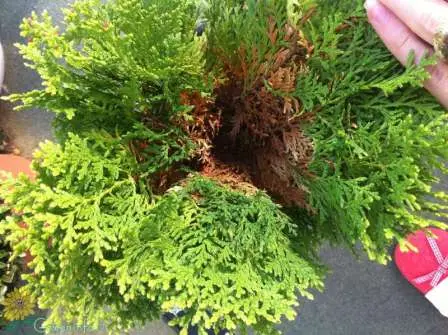
Phytophthora is one of the most dangerous fungal diseases that can only occur in thuja. This disease is accompanied by the destruction of the upper layer of the root, which subsequently causes the crown of the plant to acquire an unhealthy gray tint, and the trunk softens, becomes covered with plaque and acquires a distinct putrefactive odor.
As a rule, the cause of this disease in thuja is insufficiently good drainage and subsequent stagnation of moisture in the soil. To avoid the development of a pathogenic fungus, thuja must be treated with fungicides. If the disease has already begun to spread through the root system of the plant, then its treatment will be useless. Such a thuja will have to be destroyed, and the soil under it will be completely changed, otherwise the disease will affect other plants planted in this place.
Fuzarioz
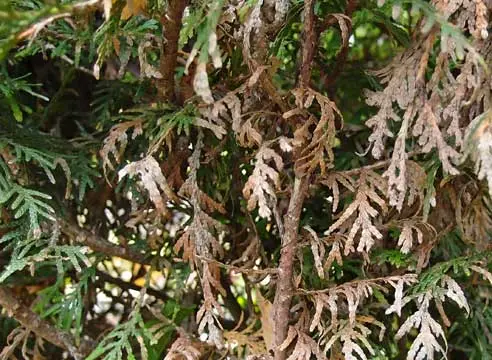
Unlike the previous disease, fusarium, or tracheomycosis wilt, is not so dangerous for thuja if the plant is treated on time. In most cases, Fusarium is provoked by a lack of lighting or prolonged waterlogging of the soil under the thuja. With this disease, the roots turn brown, and the fungus gradually grows into the underground parts of the thuja, blocking the supply of nutrient compounds. As a result, the aerial parts of the plant first dry out, and the needles turn yellow, then redden and, in the end, die off.
During the treatment of this disease, thuja should be treated with antifungal drugs, for example, a 0,2% solution of Fundazol.
brown shoots
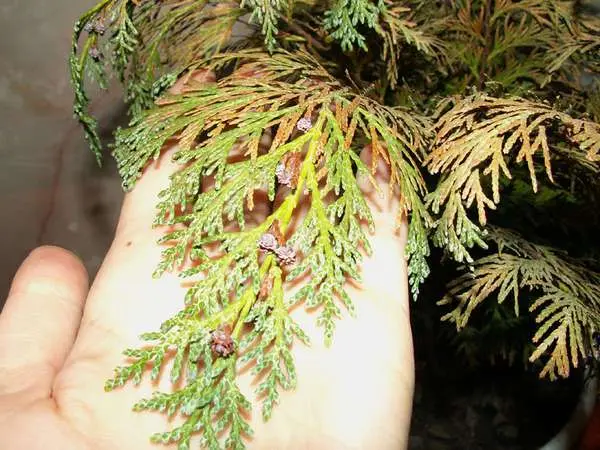
Symptoms of such a common thuja disease as brown shoots are often ignored by gardeners. But the lack of treatment can not only negatively affect the appearance of the plant, but also completely destroy the shrub.
The symptoms of this disease are quite easy to notice. The shoots of the infected thuja begin to turn yellow, moreover, the color change occurs from the top of the branches, most often in early spring. In the later stages of the disease, yellowness covers the entire shoot, and it falls off.
As a treatment, regular feeding of the thuja and the introduction of lime mixtures into the soil can help. In the period from July to October, it will not be superfluous to treat the plant with a 2% solution of Fundazole with an interval of 1 time in 2 weeks.
Rust

Rust most often affects the thuja crown, as seen in the photo, and therefore it is worth starting their treatment as soon as possible so that the plants do not lose too many needles during the course of the disease. It is believed that a disease such as rust occurs with a lack of nutrition, as well as in too dry or humid weather. In the process of infection, the thuja needles begin to darken, acquiring a copper tint, after which it falls off. The treatment of this disease consists in the timely treatment of plants with HOM, at the rate of 40 g per 10 liters of liquid, as well as the removal of the affected parts of the thuja. Fundazol fights rust on thuja no less effectively if it is treated with a solution of 20 g of a substance diluted in 10 liters of water.
Schutte

A disease such as schütte also affects mainly the needles of a young thuja. Already in early spring, it turns yellow and takes on an unaesthetic appearance due to the dense gray-black mycelium, which sticks together plant scales. You can cope with such a disease by regularly thinning the crown, spraying the plant with copper sulfate and Bordeaux liquid in spring and autumn.
Tin mushroom
The tinder fungus is able to infect a plant, penetrating into its structure through broken and injured branches. The thuja affected by the disease is overgrown with characteristic dense growths, while quickly drying out and turning yellow. In order for the plant to retain its decorative effect, you should not postpone treatment. All mushroom growths and yellowed parts should be cut off, and scrapes and scratches should be cleaned and treated with a resin-based garden pitch. It will also be useful to carry out spring and autumn processing of thuja with Bordeaux liquid.
Root rot
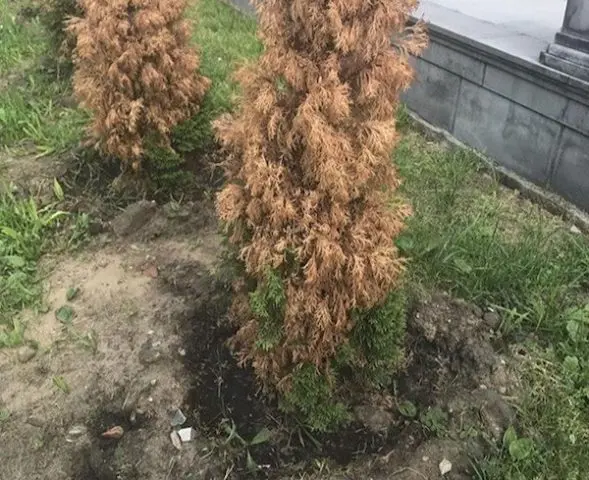
Another disease of thuja roots is root rot. It is characterized by the following symptoms:
- exfoliation of the bark at the base of the branches;
- tarnishing of thuja shoots and changing their color to brown or dirty yellow;
- the appearance of white spots on the wood;
- inhibition of plant growth.
As such, there is no treatment for root rot, however, it is possible to prevent the disease if the plants are treated with powerful fungicides, for example, a 0,2-solution of Rovral Flo 255 SC.
gray mold
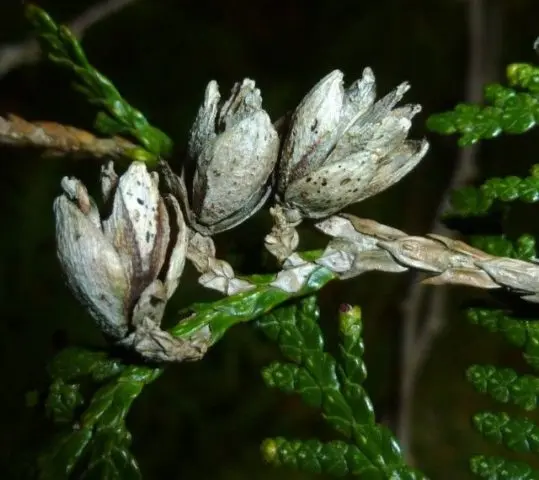
Very spoils the appearance of thuja gray mold. This fungal disease appears if the plant does not receive good enough care. At the same time, gray spots can be observed on the needles, which turn brown over time, after which the shoots die off. In the advanced stages of the disease, there is nothing left but to burn the affected plants. To prevent the fungus, it is worth treating healthy arborvitae with Biosept 33 SL or Teldor 500 SC fungicide. If necessary, the procedure can be repeated.
The most common thuja pests
In addition to diseases, some pests also pose a danger to thuja. All of them can be divided into three groups:
- sucking pests;
- mining pests;
- xylophages, or stem pests.
Although the nature of the damage of these insects is different, most of them are affected by the same substances. Nevertheless, there are still some features in the fight against them, and therefore they should be taken into account when choosing a treatment.
Dolgonosiki
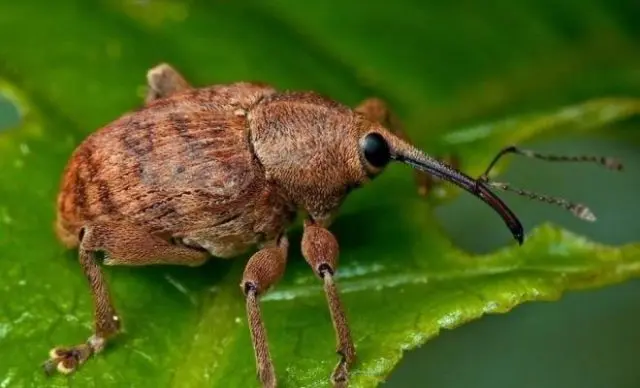
Excessively acidic soils can lead to the appearance of stem pests on the thuja – weevils, which are equally dangerous in both the larval and mature stages. Adults of these insects eat the bark of young shoots, while the larvae damage the roots of the plant. The activity of such pests provokes browning of the ends of the branches of the arborvitae and shedding of scales. The treatment in this situation is spraying thuja with insecticides and, if necessary, liming the soil under the thuja.
Thuja moth-finger-glove
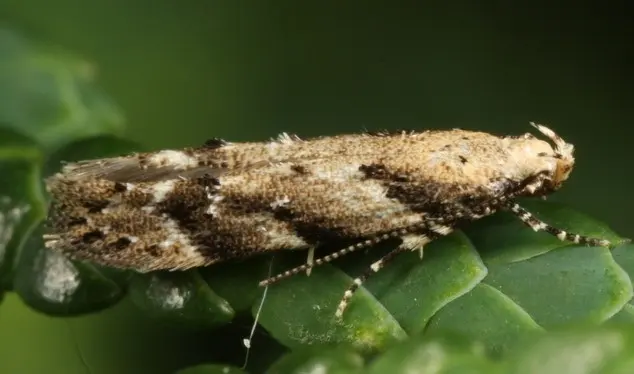
The foxtail moth is considered a mining insect. Outwardly, the adult of this pest looks like a small butterfly with a wingspan of up to 2 cm. It has a smooth or slightly scaly head with antennae and large round eyes. The narrow body and dark wings are decorated with patterns of white spots and stripes.
Like all butterflies, adult insects do not pose a direct threat to plant health. The caterpillars of these pests, on the other hand, eat through tunnels in the needles of the arborvitae, due to which it turns yellow, and the growth of the shrub slows down. The activity of such larvae is easy to detect by openings on scaly leaves. It is difficult to completely get rid of these pests, but it is possible if the infected thujas are treated 2 times with Karbofos, Kinmiks or Decis.
Thuja mining moth

Another mining pest of the thuja bears the speaking name of the thuja mining moth. Adult insects reach a length of 5 mm and have a silvery-brown color with brown stripes, which allows them to successfully camouflage against the background of the bark. These pests are most active during May-June, when the moth caterpillars begin to feed heavily before pupating. They damage the internal structure of the needles, which, in the end, leads to deformation of the shoots and the appearance of yellowness in the crown.
Various insecticides will contribute to the destruction of mining pests. The first processing of thuja should be carried out in the spring, until the moth caterpillars have moved to new shoots, and the second – at the end of summer.
thuja aphid
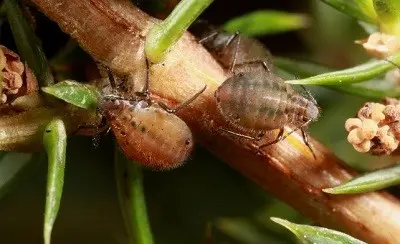
Such thuja pests as thuja aphids, which can be seen in the photo, can very significantly spoil the appearance of the thuja. These small grayish insects draw juice from the shoots at the age of 2-3 years, which, together with an enviable fertility and a colonial lifestyle, makes them very dangerous for weakened plants.
Deprived of nutrients, the needles turn brown during the summer, and die off in the fall until the trunk is exposed.
It is possible to cope with thuja pests if the plant is treated with insecticides, for example, Fufanon in the period from May to June, with re-treatment of thuja in the summer in the later stages of infection. In addition, it is advisable to wash the infected areas with a soapy composition, covering the ground so that the soap does not reach the thuja roots. Such procedures should be done regularly 1 time in 7 – 10 days during the month. In this case, it is necessary to ensure that the solution does not come into contact with the roots of the thuja.
Thuja false shield
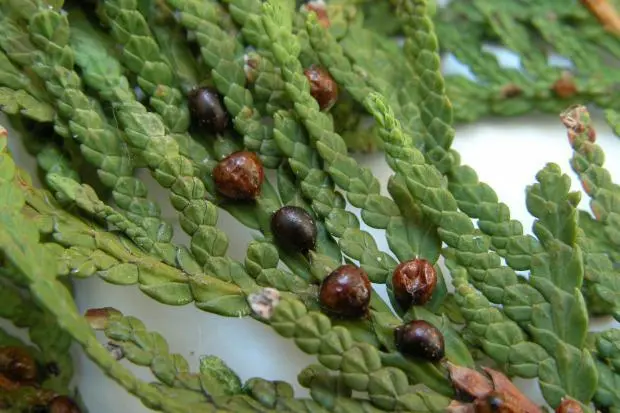
Thuja false shield is a miniature insect up to 3,5 mm in length. It has a slightly convex spherical yellow-brown body. Like the thuja aphid, the false shield is a sucking pest. The plant affected by this insect is covered with yellow ulcers, which quickly spread over the entire surface of the bark. A long absence of treatment can result in the death of the thuja, and therefore it is necessary to treat the plant with drugs already at the first alarm signals. As a rule, Aktellik, Karbofos, Antio are used for this, and connoisseurs of folk remedies use a soap-alcohol solution mixed at the rate of 15 g of soap and 10 ml of denatured alcohol per 1 liter of water.
Juniper scale insect
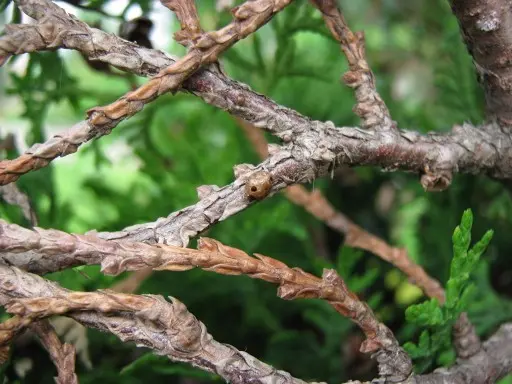
The juniper scale insect looks like a false shield in size and color of the body, but has one significant difference – its shell is attached to the body so tightly that it cannot be separated. It is believed that the scale insect does much less harm in comparison with the above-named insect, however, in large numbers they cause problems, up to the complete drying of the thuja. You can eliminate this pest in the same ways as the false shield.
Thuy and juniper beetle

A lot of trouble for gardeners is delivered by thuja and juniper beetles. They are classified as stem pests that gnaw tunnels in the bark of the thuja and feed on wood. Most often, they settle on plants that are not cared for carefully enough, however, pests can enter the site with recently acquired seedlings, so when buying thujas, you should carefully examine them. The best treatment against the invasion of beetles is the treatment with insecticidal compounds. And if you additionally treat thuja with Bordeaux liquid, pest resistance will increase significantly.
spider mite
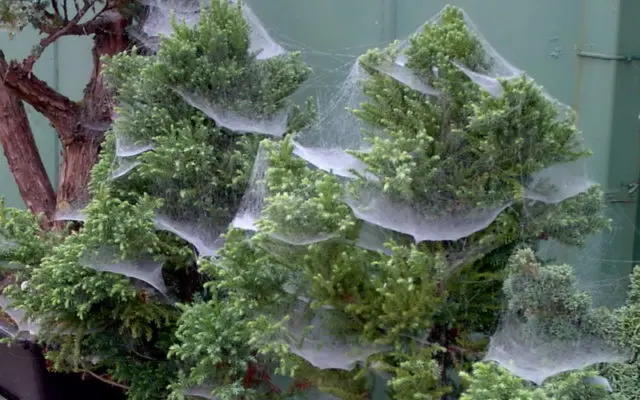
Spider mite often chooses thuja, which grow where there is insufficiently moist soil and dry air. This pest reproduces surprisingly quickly, entangling thuja with cobwebs in the course of life. Treating the shrub with acaricides, as well as infusions of garlic or dandelions, will help ward off harmful arachnids.
How to treat thuja in the spring for prevention
As you know, treating is much more difficult than preventing the development of the disease, and therefore you should not wait for the appearance of unwanted symptoms. It is better to take preventive measures that will protect the plants and increase their immunity. To do this, it is advisable to treat thuja from diseases and pests in the spring with the help of HOM, spraying them with a solution composed of 40 g of the drug per 10 liters of water. If there is a risk of damage to the root system by a fungus or infections that are in the soil, you can treat the near-stem circle with 1% Fundazol once a season.
Instead of HOM, gardeners often use Bordeaux liquid. This mixture is very popular due to its effectiveness and versatility. Thuja is also sprayed with this liquid. This happens in the spring, when new needles actively begin to grow. The optimal amount of the product is 10 l / 100 m².
In addition to using the above means, systematic examination of the plant for lesions and adherence to agricultural practices, which includes, among other things, careful sanitary pruning, will help maintain the health of the thuja.
Conclusion
Having studied the main diseases of the thuja and their treatment, you can not be afraid that with a sudden deterioration in the health of the plant, precious time will be lost. Knowing all the nuances and symptoms of diseases, even people with minimal experience in caring for infected crops will be able to save their favorite thujas from almost any ailment.









